.jpg.webp)
A warship or combatant ship is a ship that is built and primarily intended for naval warfare. Usually they belong to the armed forces of a nation.[1] As well as being armed, warships are designed to withstand damage and are typically faster and more maneuverable than merchant ships. Unlike a merchant ship, which carries cargo, a warship typically carries only weapons, ammunition and supplies for its crew. Warships usually belong to a navy, though they have also been operated by individuals, cooperatives and corporations.
In wartime, the distinction between warships and merchant ships is often blurred. Until the 17th century it was common for merchant ships to be pressed into naval service, and not unusual for more than half a fleet to be composed of merchant ships—there was not a large difference in construction, unlike the difference between a heavily armoured World War battleship and an ocean liner. Until the threat of piracy subsided in the 19th century, it was normal practice to arm larger merchant ships such as galleons. Warships have also often been used as troop carriers or supply ships, such as by the French Navy in the 18th century or the Imperial Japanese Navy during the Second World War. In war since the early 20th century, merchant ships were often armed and used as auxiliary warships, such as the Q-ships of the First World War and the armed merchant cruisers of the Second World War.
History and evolution of warships
First warships
The first evidence of ships being used for warfare was in Ancient Egypt, specifically the northern Nile River most likely to defend against Mediterranean peoples. The galley warship most likely originated in Crete an idea which was soon copied and popularized by the Phoenicians. In the time of Mesopotamia, Ancient Persia, Phoenicia, Ancient Greece and the Ancient Rome, warships were always galleys (such as biremes, triremes and quinqueremes): long, narrow vessels powered by banks of oarsmen and designed to ram and sink enemy vessels, or to engage them bow-first and follow up with boarding parties. The development of catapults in the 4th century BC and the subsequent refinement of this technology enabled the first fleets of siege engine - equipped warships by the Hellenistic age. During late antiquity, ramming fell out of use and the galley tactics against other ships used during the Middle Ages until the late 16th century focused on boarding.
The Age of Sail
Naval artillery was redeveloped in the 14th century, but cannon did not become common at sea until the guns were capable of being reloaded quickly enough to be reused in the same battle. The size of a ship required to carry a large number of cannons made oar-based propulsion impossible, and warships came to rely primarily on sails. The sailing man-of-war emerged during the 16th century.
By the middle of the 17th century, warships were carrying increasing numbers of cannons on their broadsides and tactics evolved to bring each ship's firepower to bear in a line of battle. The man-of-war now evolved into the ship of the line. In the 18th century, the frigate and sloop-of-war – too small to stand in the line of battle – evolved to escort convoy trade, scout for enemy ships and blockade enemy coasts.[2]
 Diagrams of first and third rate warships, England, 1728
Diagrams of first and third rate warships, England, 1728
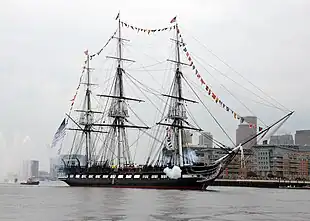 American sailing frigate USS Constitution
American sailing frigate USS Constitution American sloop-of-war USS Constellation in 2012
American sloop-of-war USS Constellation in 2012 Starboard side of the British ship of the line HMS Victory
Starboard side of the British ship of the line HMS Victory
Steel, steam and shellfire
During the 19th century a revolution took place in the means of marine propulsion, naval armament and construction of warships. Marine steam engines were introduced, at first as an auxiliary force, in the second quarter of the 19th century. The Crimean War gave a great stimulus to the development of guns. The introduction of explosive shells soon led to the introduction of iron, and later steel, naval armour for the sides and decks of larger warships. The first ironclad warships, the French Gloire and British Warrior, made wooden vessels obsolete. Metal soon entirely replaced wood as the main material for warship construction.
From the 1850s, the sailing ships of the line were replaced by steam-powered battleships, while the sailing frigates were replaced by steam-powered cruisers. The armament of warships also changed with the invention of the rotating barbettes and turrets, which allowed the guns to be aimed independently of the direction of the ship and allowed a smaller number of larger guns to be carried.
The final innovation during the 19th century was the development of the torpedo and development of the torpedo boat. Small, fast torpedo boats seemed to offer an alternative to building expensive fleets of battleships.
 French ship-of-the-line Napoléon, the first steam powered battleship.
French ship-of-the-line Napoléon, the first steam powered battleship.
_(14760501954).jpg.webp) Casemate ironclad USS Cairo on a contemporary photograph.
Casemate ironclad USS Cairo on a contemporary photograph..jpg.webp)
.jpg.webp) HMS Devastation was the first sea-going ironclad to not use sails and completely rely on its steam engines.
HMS Devastation was the first sea-going ironclad to not use sails and completely rely on its steam engines.
Pre-dreadnought era
Pre-dreadnought battleships were sea-going battleships built between the mid- to late- 1880s and 1905, before the launch of HMS Dreadnought in 1906. The pre-dreadnought ships replaced the ironclad battleships of the 1870s and 1880s. Built from steel, protected by case-hardened steel armour, and powered by coal-fired triple-expansion steam engines, pre-dreadnought battleships carried a main battery of very heavy guns in fully-enclosed rotating turrets supported by one or more secondary batteries of lighter weapons. The role of corvettes, sloops and frigates were taken by new types of ships like destroyers, protected cruisers and armoured cruisers.
.jpg.webp) HMS Havock, the first true destroyer.
HMS Havock, the first true destroyer.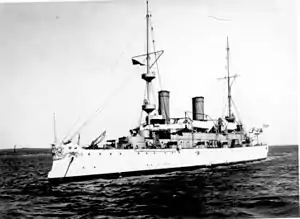

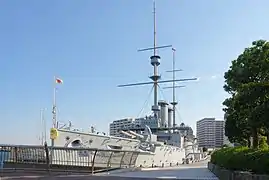
Since 1906
The dreadnought era
Another revolution in capital warship design began shortly after the start of the 20th century, when Britain launched the Royal Navy's all-big-gun battleship Dreadnought in 1906. Powered by steam turbines, it was bigger, faster and more heavily gunned than any existing battleships, which it immediately rendered obsolete. It was rapidly followed by similar ships in other countries. The Royal Navy also developed the first battlecruisers. Mounting the same heavy guns as the dreadnoughts on an even larger hull, battlecruisers sacrificed armour protection for speed. Battlecruisers were faster and more powerful than all existing cruisers, but much more vulnerable to shellfire than contemporary battleships. The torpedo-boat destroyer was developed at the same time as the dreadnoughts. Bigger, faster and more heavily gunned than the torpedo boat, the destroyer evolved to protect the capital ships from the menace of the torpedo boat.
At this time, Britain also introduced the use of fuel oil to power steam warships, instead of coal. Oil produced twice as much power per unit weight as coal, and was much easier to handle.[3][4] Tests were conducted by the Royal Navy in 1904 involving the torpedo-boat destroyer Spiteful, the first warship powered solely by fuel oil.[5][6] These proved its superiority, and all warships procured for the Royal Navy from 1912 were designed to burn fuel oil.[7][8]
 The all-big-gun steam-turbine-driven dreadnought battleship HMS Dreadnought
The all-big-gun steam-turbine-driven dreadnought battleship HMS Dreadnought_British_Battleship.jpg.webp) HMS Invincible, the first battlecruiser
HMS Invincible, the first battlecruiser
Obsolescence of battleships
During the lead-up to the Second World War, Germany and Great Britain once again emerged as the two dominant Atlantic sea powers. The German navy, under the Treaty of Versailles, was limited to only a few minor surface ships. But the clever use of deceptive terminology, such as Panzerschiffe deceived the British and French commands. They were surprised when ships such as Admiral Graf Spee, Scharnhorst, and Gneisenau raided Allied supply lines. The greatest threat however, was the introduction of the Kriegsmarine's largest vessels, Bismarck and Tirpitz. Bismarck was heavily damaged and sunk/scuttled after a series of sea battles in the north Atlantic in 1941, while Tirpitz was destroyed by the Royal Air Force in 1944. The British Royal Navy gained dominance of the European theatre by 1943.
The Second World War brought massive changes in the design and role of several types of warships. For the first time, the aircraft carrier became the clear choice to serve as the main capital ship within a naval task force. World War II was the only war in history in which battles occurred between groups of carriers. World War II saw the first use of radar in combat. It brought the first naval battle in which the ships of both sides never engaged in direct combat, instead sending aircraft to make the attacks, as in the Battle of the Coral Sea.
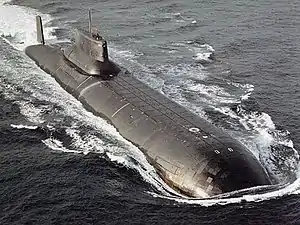
Cold War-era
Modern warships are generally divided into seven main categories, which are: aircraft carriers, cruisers,[lower-alpha 1] destroyers, frigates, corvettes, submarines, and amphibious warfare ships. Battleships comprise an eighth category, but are not in current service with any navy in the world. Only the deactivated American Iowa-class battleships still exist as potential combatants, and battleships in general are unlikely to re-emerge as a ship class without redefinition. The destroyer is generally regarded as the dominant surface-combat vessel of most modern blue-water navies. However, the once distinct roles and appearances of cruisers, destroyers, frigates, and corvettes have blurred. Most vessels have come to be armed with a mix of anti-surface, anti-submarine and anti-aircraft weapons. Class designations no longer reliably indicate a displacement hierarchy, and the size of all vessel types has grown beyond the definitions used earlier in the 20th century. Another key difference between older and modern vessels is that all modern warships are "soft", without the thick armor and bulging anti-torpedo protection of World War II and older designs.
Most navies also include many types of support and auxiliary vessels, such as minesweepers, patrol boats and offshore patrol vessels.
By 1982 the United Nations Convention on the Law of the Sea (UNCLOS) treaty negotiations had produced a legal definition of what was then generally accepted as a late-twentieth century warship. The UNCLOS definition was : "A warship means a ship belonging to the armed forces of a State bearing the external marks distinguishing such ships of its nationality, under the command of an officer duly commissioned by the government of the State and whose name appears in the appropriate service list or its equivalent, and manned by a crew which is under regular armed forces discipline."[1]
Development of the submarine

The first practical submarines were developed in the late 19th century, but it was only after the development of the torpedo that submarines became truly dangerous (and hence useful). By the end of the First World War submarines had proved their potential. During the Second World War Nazi Germany's fleet of U-boats (submarines) almost starved Britain into submission and inflicted huge losses on US coastal shipping. The success of submarines led to the development of new anti-submarine convoy escorts during the First and Second World Wars, such as the destroyer escort. Confusingly, many of these new types adopted the names of the smaller warships from the age of sail, such as corvette, sloop and frigate.
Development of the aircraft carrier
A seaplane tender is a ship that supports the operation of seaplanes. Some of these vessels, known as seaplane carriers, could not only carry seaplanes but also provided all the facilities needed for their operation; these ships are regarded by some as the first aircraft carriers and appeared just before the First World War.
A major shift in naval warfare occurred with the introduction of the aircraft carrier. First at Taranto and then at Pearl Harbor, the aircraft carrier demonstrated its ability to strike decisively at enemy ships out of sight and range of surface vessels. By the end of the Second World War, the carrier had become the dominant warship.
 Foudre, the first seaplane carrier circa 1914.
Foudre, the first seaplane carrier circa 1914.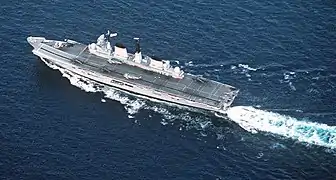 HMS Invincible (1991), a light aircraft carrier
HMS Invincible (1991), a light aircraft carrier%252C_USS_Long_Beach_(CGN-9)_and_USS_Bainbridge_(DLGN-25)_underway_in_the_Mediterranean_Sea_during_Operation_Sea_Orbit%252C_in_1964.jpg.webp) USS Enterprise (1961) and escorts
USS Enterprise (1961) and escorts
Development of the amphibious assault ship
Shinshū Maru was a ship of the Imperial Japanese Army during World War II. She was the world's first purpose-built landing craft carrier ship, and a pioneer of modern-day amphibious assault ships. During some of her operations, she was known to have used at least four cover names, R1, GL, MT, and Ryujo Maru.
An amphibious warfare ship is an amphibious vehicle warship employed to land and support ground forces, such as marines, on enemy territory during an amphibious assault. Specialized shipping can be divided into two types, most crudely described as ships and craft. In general, the ships carry the troops from the port of embarkation to the drop point for the assault and the craft carry the troops from the ship to the shore. Amphibious assaults taking place over short distances can also involve the shore-to-shore technique, where landing craft go directly from the port of embarkation to the assault point. Amphibious assault ships have a well deck with landing craft which can carry tanks and other armoured fighting vehicles and also have a deck like a helicopter carrier for helicopters and V/STOL aircraft.
 Japanese amphibious assault ship Shinshū Maru
Japanese amphibious assault ship Shinshū Maru_(690281003).jpg.webp) USS Iwo Jima in New Orleans Robert Jay Stratchko, 2005
USS Iwo Jima in New Orleans Robert Jay Stratchko, 2005.jpg.webp) Stern view of Ōsumi-class tank landing ship
Stern view of Ōsumi-class tank landing ship.jpg.webp)
Types
- Amphibious warfare ships are warships employed to land and support ground forces, such as marines, on enemy territory during an amphibious assault.
- Amphibious assault ship is a type of amphibious warfare ship employed to land and support ground forces with ship-deployed helicopters and V/STOL aircraft on enemy territory by an amphibious assault.
- Amphibious transport dock is an amphibious warfare ship, that embarks, transports, and lands elements of a landing force for expeditionary warfare missions.
- Dock landing ship is an amphibious warfare ship with a well dock to transport and launch landing craft and amphibious vehicles.
- Landing craft are small and medium seagoing watercraft, such as boats and barges, used to convey a landing force (infantry and vehicles) from the sea to the shore during an amphibious assault.
- Landing Craft Utility is a type of landing craft used by amphibious forces to transport equipment and troops to the shore. They are capable of transporting tracked or wheeled vehicles and marines from amphibious assault ships to beachheads.
- Landing Craft Mechanized is a landing craft designed for carrying vehicles during amphibious assaults.
- Landing ship, tank is the naval designation for ships first developed during World War II to support amphibious operations by carrying tanks, armoured fighting vehicles, transport vehicles, cargo, and landing troops directly onto shore with no docks or piers.
- Landing Craft Support were two distinct classes of amphibious warfare vessels used by the United States Navy during World War II to support landing crafts.
- Armed merchantman is a type of merchant ship equipped with naval guns, usually for defensive purposes, either by design or after the fact. In the days of sail, piracy and privateers.
- Armed yachts were modified yachts that were armed with weapons and were typically in the service of a navy.
- Balloon carrier was a type of ship equipped with an hot-air balloon tied to the ship with a rope or cable, which was used for observation. This type of ship was later replaced by the seaplane carrier.
- Cottonclad warships were steam-powered warships with bales of cotton lining as armour used in the American Civil War. The armaments consisted of a ram, random numbers of different cannons and sharpshooters.
- Dispatch boats were small boats, and sometimes large ships, tasked to carry military dispatches from ship to ship or from ship to shore or, in some cases from shore to shore. Dispatch boats were employed when other means of transmitting a message was not possible or safe or as quick.
- Aviso, a kind of dispatch boat
- Brig of War is a brig armed for use by a navy.
- Anti-submarine warfare carrier is a type of small aircraft carrier whose primary role is as the nucleus of an anti-submarine warfare hunter-killer group.
- Capital ship, the largest and most important ships in a nation's fleet. These were previously battleships, battlecruisers, and aircraft carriers, but the first two warship types are now no longer used.
- Aircraft carrier, a warship primarily armed with carrier-based aircraft.
- Fleet carrier is an aircraft carrier designed to operate with the main fleet of a nation's navy.
- Light aircraft carrier is an aircraft carrier that is smaller than the standard carriers of a navy.
- Escort carrier, also called a "jeep carrier" or "baby flattop" is a slow type of aircraft carrier used during WWII.
- Battlecruiser, a ship with battleship-level armament and cruiser-level armour; typically faster than a battleship because the reduction in armour allowed mounting of more powerful propulsion machinery, or the use of a more slender hull shape with a lower drag coefficient.
- Battleship, a large, heavily armored warship equipped with many powerful guns. A term which generally post-dates sailing warships.
- Ironclad battleship, battleships built before the pre-dreadnought in the 1870s and 1880s.
- Pre-dreadnought battleship, sea-going battleships built to a common design before the launch of dreadnoughts, between the mid-1880s and 1905. Pre-dreadnoughts commonly featured a mixed main battery composed of several different caliber guns.
- Dreadnought, an early 20th-century battleship, which set the pattern for all subsequent battleship construction. Dreadnoughts differ from pre-dreadnoughts in that they feature an all-big-gun main battery. The advantage lies in that if all the big guns have the same characteristics, only one firing solution will be needed to aim them all.
- Fast battleships were battleships which emphasized speed without – in concept – undue compromise of either armor or armament
- Aircraft carrier, a warship primarily armed with carrier-based aircraft.
- Bomb vessels were wooden sailing ships which carried mortars instead of cannons.
- Coastal defence ship, a type of cruiser-sized warship built for the purpose of coastal defense.
- Commerce raider, any armed vessel—privately or government-owned—sanctioned to raid a nation's merchant fleet.
- Merchant raiders are disguised commerce raiders.
- Corvettes were small ships during the age of sail. The concept was revived again in WWII as a merchant convoy escort and anti-submarine ship. They were only used by the Royal Navy and the Royal Canadian Navy. Today they are used for anti-submarine warfare and patrolling.[10]
- Cruiser, a fast, independent warship. Traditionally, cruisers were the smallest warships capable of independent action. Along with battleships and battlecruisers, they have largely vanished from modern navies.
- Armored cruiser was a type of warship of the late 19th and early 20th centuries. It was designed like other types of cruisers to operate as a long-range, independent warship, capable of defeating any ship apart from a battleship and fast enough to outrun any battleship it encountered.
- Scout cruiser was a type of warship of the early 20th century, which were smaller, faster, more lightly armed and armoured than protected cruisers or light cruisers, but larger than contemporary destroyers. They were used for scouting.
- Protected cruiser is a type of naval cruiser of the late-19th century, gained their description because an armoured deck offered protection for vital machine-spaces from fragments caused by shells exploding above them.
- Torpedo cruiser is a type of cruiser that is armed primarily with torpedoes.
- Unprotected cruiser was a type of naval cruiser in use during the early 1870s Victorian or pre-dreadnought era.
- Heavy cruiser was a type of cruiser, a naval warship designed for long range and high speed, armed generally with naval guns of roughly 203 mm in caliber, its parameters were dictated by the Washington Naval Treaty of 1922 and the London Naval Treaty of 1930.
- Light cruiser is a type of small or medium-sized warship. The term is a shortening of the phrase "light armored cruiser", describing a small ship that carried armor in the same way as an armored cruiser: a protective belt and deck.
- Large cruiser is the class of the battlecruiser-sized Alaska-class cruisers of the United States Navy during World War II.
- Guided missile cruisers are cruisers armed anti-ship missiles.
- Aircraft cruiser (also known as aviation cruiser or cruiser-carrier) is a type of warship that combines the features of the aircraft carrier and a surface warship such as a cruiser or battleship.
- Destroyer, a fast and highly maneuverable warship, traditionally incapable of independent action. Originally developed to counter the threat of torpedo boats, they are now the largest independent warship generally seen on the ocean.
- Guided missile destroyer are destroyers armed with anti-ship missiles.
- Destroyer escort was the United States Navy mid-20th-century classification for a 20-knot (37 km/h; 23 mph), warship designed with the endurance necessary to escort mid-ocean convoys of merchant marine ships similar to frigates.
- Fast attack crafts are a small, fast, agile, offensive, often affordable type of warships armed with anti-ship missiles, guns or torpedoes.
- Fire ship, a vessel of any sort set on fire and sent into an anchorage or fleet with the intention of causing destruction and chaos. Exploding fire ships are called hellburners.
- Frigate, originally a medium-sized sailing ship. Frigates used in modern navies (although they date back to the 17th century) are typically used to protect merchant vessels and other warships.
- Armoured frigate are frigates with armour which was added to ships based on existing frigate and ship of the line designs. The additional weight of the armour on these first ironclad warships meant that they could have only one gun deck, and they were technically frigates, even though they were more powerful than existing ships-of-the-line and occupied the same strategic role.
- Guided missile frigates are frigates armed with anti-ship missiles.
- Galleass, a sailing and rowing warship, equally well suited to sailing and rowing.
- Galleon, a 16th-century armed cargo carriers.
- Hellenistic galleys, warships propelled by oars with a sail for use in favorable winds used in the Mediterranean Sea.
- Bireme, an ancient vessel, propelled by two banks of oars.
- Trireme, an ancient warship propelled by three banks of oars.
- Quadrireme, an ancient warship invented in Carthage with two levels of oarsmen, and was therefore lower than the quinquereme.
- Quinquereme, an ancient warship propelled by three banks of oars. On the upper row, two rowers hold one oar; on the middle row, two rowers; and on the lower row, one man to an oar.
- Hexareme, an ancient warship invented in Syracuse. The exact arrangement of the hexareme's oars is unclear. If it evolved naturally from the earlier designs, it would be a trireme with two rowers per oar.
- Septireme, an ancient warship invented by the Macedonia, the septireme was derived by adding a standing rower to the lower level of the hexareme.
- Octeres, very little is known about the octeres, at least two of their type were in the fleet of Philip V of Macedon at the Battle of Chios.
- Enneres, a type of warship whose oaring system may have been a modification of the quadrireme, with two teams of five and four oarsmen.
- Deceres, a type of warship which is present alongside "nines" in the fleet of Antigonus I Monophthalmus in 315 BC. It is most likely that the "ten" was derived from adding another oarsman to the "nine".
- Tessarakonteres, a very large catamaran galley reportedly built by Ptolemy IV Philopator of Egypt. It had seven naval rams, with one primary, and the deck would have provided a stable platform for catapults that were often mounted on supergalleys. However, the "forty" was likely just a showpiece; Plutarch describes the ship as for exhibition only.
- Lembos, light warships most commonly associated with the vessels used by the Illyrian tribes, chiefly for piracy, in the area of Dalmatia. Was soon adopted by Macedonia, Seleucid Empire, Roman Republic and Sparta.
- Hemiolia, light and fast warship that appeared in the early 4th century BC. It was particularly favoured by pirates in the eastern Mediterranean, but also used by Alexander the Great as far as the rivers Indus and Jhelum, and by the Romans as a troop transport. According to one view, it was manned by half the number of oarsmen to make room for the soldiers. According to another, there were one and a half files of oarsmen on each side, with the additional half file placed amidships, where the hull was wide enough to accommodate them.
- Trihemiolia, this type was classed with the trireme, and had two and a half files of oarsmen on each side. Judging from the Lindos relief and the famous Nike of Samothrace, both of which are thought to represent trihemioliai, the two upper files would have been accommodated in an oarbox, with the half-file located beneath them in the classic thalamitai position of the trireme.
- Liburna, a type of small galley used for raiding and patrols. It was originally used by the Liburnians, a pirate tribe from Dalmatia, and later used by the Roman Navy. It had one bench with 25 oars on each side, while in the late Roman Republic, it was equipped with two banks of oars (a bireme), remaining faster, lighter, and more agile than triremes.
- Gunboats are naval watercrafts designed for the express purpose of carrying one or more guns to bombard coastal targets.
- River gunboat is a type of gunboat for riverine use.
- Flat-iron gunboats were a number of classes of coastal gunboats generally characterized by small size, low freeboard, the absence of masts, and the mounting of a single non-traversing large gun, aimed by pointing the vessel.
- Torpedo gunboat were a form of gunboat armed with torpedoes and designed for hunting and destroying smaller torpedo boats.
- Motor gunboat is a type of a fast gunboat armed with machine-guns and autocannons.
- Grab was a type of ship common on the Malabar Coast in the 18th and 19th centuries. The ghurāb was originally a galley, but the type evolved into sailing ships armed with cannons.
- Gallivat were small, armed type of boats, with sails and oars, armed with swivel guns and used on the Malabar Coast in the 18th and 19th centuries.
- Helicopter carrier, an aircraft carrier especially suited to carry helicopters and V/STOL aircraft.
- Ironclad, a wooden warship with external iron plating.
- Casemate ironclad were a type of ironclad gunboats used in the American Civil War.
- Central battery ship in European continental navies, was a development of the (high-freeboard) broadside ironclad of the 1870s
- Turret ship was a 19th-century type of warship, the earliest to have their guns mounted in a revolving gun turret, instead of a broadside arrangement.
- Floating battery is a kind of armed watercraft, often improvised or experimental, which carries heavy armament but has few other qualities as a warship.
- Littoral Combat Ship is a United States Navy classification of warships with the size and role of corvettes.
- Longship, a Viking raiding ship.
- Man-of-war, a British Navy expression for a sailing warship.
- Minesweeper are small warships designed to remove or detonate naval mines.
- Minehunter are naval vessels that seek, detect, and destroys individual naval mines.
- Mine countermeasures vessels are atype of naval ships designed for the location of and destruction of naval mines which combines the role of a minesweeper and minehunter in one hull.
- Minelayer are naval vessels that plant naval mines offshore.
- Missile boats are small, fast warship armed with anti-ship missiles.
- Monitor, a type of small, heavily gunned warships with shallow draft designed for shore bombardment.
- River monitor, a type of monitors used in rivers.
- Breastwork monitor was a modification of the monitor by Sir Edward Reed of the Royal Navy.
- Naval trawlers are vessels built along the lines of fishing trawlers but fitted out for naval purposes
- Naval drifters are boats built along the lines of a commercial fishing drifter but fitted out for naval purposes.
- Patrol vessels are relatively small naval vessels generally designed for coastal defence, border protection, immigration law-enforcement, search and rescue duties.
- Q-ship, also known as Q-boats, decoy vessels, special service ships, or mystery ships, were heavily armed merchant ships with concealed weaponry, designed to lure submarines into making surface attacks. This gave Q-ships the chance to open fire and sink them.
- Seaplane tenders were a type of ship used to carry seaplanes into the open sea. They are considered by some as the predecessor of the aircraft carrier.
- Submarine chaser is a small warship used in anti-submarine warfare.
- Ship of the line, a sailing warship capable of standing in the line of battle. A direct predecessor to the later battleship.
- Sloop-of-war was a sailing vessel category later revived in WWII as a convoy escort ship.
- Screw sloop was a propeller-driven sloop-of-wars used during the mid-19th Century.
- Submarine, are ships capable of staying submerged for days. Modern submarines can stay underwater for months, with food supplies as the only limiting factor.
- Cruiser submarine were a type of a very large submarine designed to remain at sea for extended periods in areas distant from base facilities.
- Coastal submarine or littoral submarine is a small, maneuverable type of submarine with shallow draft well suited to navigation of coastal channels and harbors.
- Fleet submarine is a type of submarine with the speed, range, and endurance to operate as part of a navy's battle fleet.
- Midget submarine is any submarine under 150 tons, typically operated by a crew of one or two but sometimes up to six or nine
- Submarine aircraft carrier is a submarine equipped with aircraft for observation or attack missions. These submarines saw their most extensive use during World War II, although their operational significance remained small
- Attack Submarine is a submarine with the purpose of attacking other submarines.
- Ballistic Missile Submarine is a submarine capable of deploying submarine-launched ballistic missiles (SLBMs) with nuclear warheads.
- Cruise missile submarine are submarines equipped with cruise missiles
- Geobukseon (literally Turtle ship) were wooden sail and oar propelled Korean warships armed with cannons.
- Panokseon (literally board roofed ship) were a type of Korean wooden warships propelled by both sailing and rowing armed with cannons and Hwacha multiple rocket launchers.
- Atakebune were wooden oar propelled 16th Century Japanese warships armed with few cannons, arquebusiers and archers. They were mostly bulky floating fortifications.
- Mengchong (literally Covered Assaulter) was a type of leather-covered assault warship used in the 2nd and 3rd centuries CE in China.
- Louchuan (literally Tower Ship) was a type of warship used as a floating fortress in Ancient China. The Louchuan was meant to board troops onto enemy ships. Although they were also armed with trebuchets for ranged combat.
- Wugongchuan (literally Centipede Ship) was a Chinese oared vessel of the 16th century inspired by the Portuguese galley.
- Torpedo boat, are small, fast surface vessels designed for launching torpedoes.
- Torpedo ram is a type of torpedo boat combining a ram with torpedo tubes.
- Motor torpedo boat is a type of fast torpedo boat, especially of the mid 20th century.
- War canoe was a kind of watercraft of the canoe type designed and outfitted for warfare using bow, spear and shield wielding warriors. During the gunpowder era a single brass or iron cannon was mounted on the bow or stern along with musketeers. These warships were used by many tribes and cultures all around the globe.
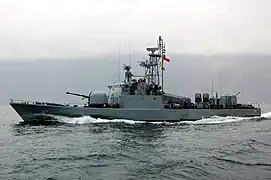 A fast attack craft of the Chilean Navy
A fast attack craft of the Chilean Navy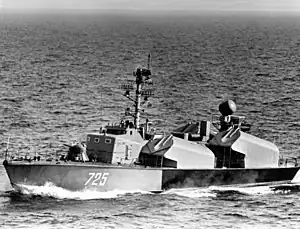 An Osa I class missile boat in 1983.
An Osa I class missile boat in 1983. INS Sunayna, an Indian Offshore Patrol Vessel
INS Sunayna, an Indian Offshore Patrol Vessel Magdeburg, a German Braunschweig-class corvette (2008)
Magdeburg, a German Braunschweig-class corvette (2008) A German Sachsen-class frigate (2006)
A German Sachsen-class frigate (2006) British destroyer HMS Daring visiting Gibraltar in 2016
British destroyer HMS Daring visiting Gibraltar in 2016_departed_on_deployment.jpg.webp) American cruiser USS Port Royal in September 2003
American cruiser USS Port Royal in September 2003 Russian battlecruiser Kirov, 1983
Russian battlecruiser Kirov, 1983
See also
Notes
- ↑ The Kirov-class battlecruiser is a guided missile cruiser that straddles the line between a heavy cruiser and a battlecruiser. They are often called battlecruiser by Western defense commentators.[9]
References
Footnotes
- 1 2 "United Nations Convention on the Law of the Sea. Part II, Subsection C". United Nations. Retrieved 28 June 2015.
- ↑ Winfield, Rif; Roberts, Stephen S. (2017-10-30). French Warships in the Age of Sail 1626–1786. Pen & Sword Books Limited. ISBN 9781473893535.
- ↑ Bacon 1901, p. 246.
- ↑ Dahl 2001, p. 51.
- ↑ Anon. 1904b, p. 27.
- ↑ Lyon 2005, p. 80.
- ↑ Lyon 2005, p. 97.
- ↑ Siegel 2002, p. 181.
- ↑ Armi da guerra, De Agostini, Novara, 1985.
- ↑ "Corvette | Fast, Maneuverable & Deadly | Britannica".
Bibliography
- Anon. (1904b), "The British Admiralty ...", Scientific American, 91 (2), ISSN 0036-8733
- Bacon, R.H.S. (1901), "Some notes on naval strategy", in Leyland, J. (ed.), The Naval Annual 1901, pp. 233–52, OCLC 496786828
- Dahl, E.J. (2001), "Naval innovation: From coal to oil" (PDF), Joint Force Quarterly (Winter 2000–01): 50–6, archived (PDF) from the original on 22 October 2016, retrieved 28 November 2016
- Lyon, D. (2005) [1996], The First Destroyers, Mercury, ISBN 1-84560-010-X
- Siegel, J. (2002), Endgame: Britain, Russia, and the Final Struggle for Central Asia, I.B. Tauris, ISBN 1-85043-371-2


.jpg.webp)